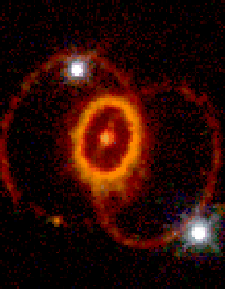Some stars explode. The explosion is called a "supernova". This picture shows one supernova.
Click on image for full size
NASA and STScI
Exploding Stars
Stars don't last forever. Occasionally, a star bigger than our Sun will end its life in a huge explosion, called a supernova.
This explosion happens because the center, or core, of the star heats up very fast. The outer layers of the star are blown off in the explosion. The shock waves and material that fly out from the supernova can cause the formation of new stars.
Supernovae last one or two years, and can shine brighter than a whole galaxy for this time. There are many beautiful pictures of the gas clouds remaining after supernovae.
What happens to the star after the supernova depends on how big it was to begin with. If the star was only a little bigger than the Sun, the core will shrink into a tiny neutron star only a few miles across. If the star was much bigger than the Sun, the core will shrink down to a black hole.
You might also be interested in:
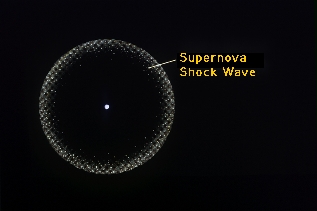
Scientists believe that the solar system was formed when the cloud of gas and dust was disturbed, maybe by the explosion of a nearby star. Such an explosion is called a supernova. A supernova makes waves
...more
Scientists have found where cosmic rays come from! The rays are made of atoms. These atoms are flying through space at speeds close to the speed of light. Until now, scientists didn't know where they
...more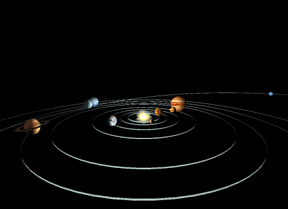
Scientists believe that the solar system was formed when a cloud of gas and dust in space was disturbed, maybe by the expl osion of a nearby star (called a supernova). This explosion made waves in space
...more
Williamina Paton Stevens Fleming was a Scottish-American astronomer who lived from 1857-1911. She discovered 10 of the 24 novae then known. Novae are stars that suddenly become very bright then fade over
...more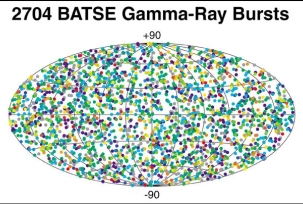
Satellites in the 1960's looked for a type of light called Gamma Rays. They found bursts of Gamma Rays coming from outer space! They can't hurt you. They are stopped by the Earth's atmosphere. We have
...more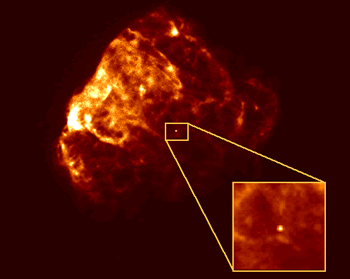
Neutron Stars form when really big stars die. When such a star runs out of fuel its center begins to collapse under gravity. When the center collapses the entire star collapses. The surface of the star
...more
An element (also called a "chemical element") is a substance made up entirely of atoms having the same atomic number; that is, all of the atoms have the same number of protons. Hydrogen, helium, oxygen,
...more


